Managing Urethral Obstructions in the Cat
What’s a Urethral Obstruction in a Cat?
The problem is almost exclusively seen in the male cat. It occurs only rarely in the female. The cat’s urethra becomes obstructed either physically by stones or an organic gritty material (struvite) or functionally because of a severe urethral spasm. In either case, the cat is unable to properly empty his bladder.
Situational Awareness (Urethral Obstruction):
Urethral obstruction in the cat is a common issue and can be life threatening if not handled immediately. The most common reason for cats to obstruct is urethral spasms (idiopathic); followed by uroliths.
The immediate treatment requires retropulsing the stones back into the bladder (if present) and placing an indwelling urethral catheter for approximately 48 hours. During this time period, appropriate medical management of urethral spasm is initiated; dietary management for uroliths or organic/struvite matrix begun; and, if necessary a cystotomy planned to remove the stones from bladder.
Success rate with the initial unblocking treatment is very high (96%). Recurrence of the obstruction is noted in approximately 40% within the year, therefore proper management of the initial cause of the blockage, follow-up and owner compliance are very important.
Pre-Catheterization Considerations:
•Is he hypokalemic
•Can the bladder be emptied (at least temporarily) until patient’s cardiac function is adequate.
•Safest drugs to sedate or anesthetized are utilized (see Section by Dr. Nancy Brock DACVAA)
What’s a Perineal Urethrostomy (PU) in cats:
The intent of the PU is to create a new opening (stoma) at the level of the PELVIC urethra. This is where the urethra is at its widest and therefore the least likely to be obstructed by the passage of small uroliths or organic debris. In order to accomplish that, the entire penile urethra (and therefore the penis) must be amputated.
Situational Awareness (PU):
This is a LIFE SAVING surgery. Unfortunately, the PU has a bad reputation because of a reported high rate of stricturing.
The truth is that the most common reason why cats reblock/stricture is because the PU was improperly done. In order to get to the wide perlvic urethra you have to free up the penis and penile urethra from its attachments to the pelvis. This part can give the inexperienced surgeon trepidation (and it should).
The truth is that the most common reason why cats reblock/stricture is because the PU was improperly done. In order to get to the wide perlvic urethra you have to free up the penis and penile urethra from its attachments to the pelvis. This part can give the inexperienced surgeon trepidation (and it should).
The inexperienced often stop short of the goal and make the new opening just above the current obstruction, in the penile urethra rather than the pelvic urehtra. Don’t make this mistake.
Ascending urethritis/cystitis can occur in PU cats. Although a nuisance, this problem is readily managed medically and should not be a deterrent for proceeding with the surgery.
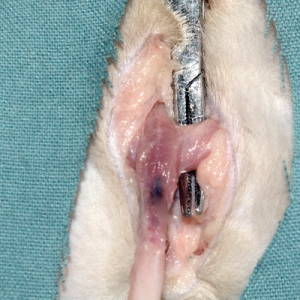
$450
Get Ready for Managing the Urethral Obstruction in a Cat
All the information you need.
Fully narrated surgical videos.
In depth guide and more.
Pre-Surgical Considerations:
When is it time to perform a PU:
- Unresolvable urethral obstruction
- Recurrent urethral obstruction (see video)
- Distal urethral injury or neoplasia
Stabilize the patient:
- Relieve the obstruction (under sedation)
- Place an indwelling catheter
- Push the fluids
- If necessary, empty the bladder via cystocentesis
Preoperative diagnostics:
- Blood work for azotemia and electrolyte imbalances
- Survey radiographs of the caudal abdomen including the perineum
- Urinalysis
What the client needs to know:
- PU (properly done) has a high success rate.
- Over 92% of owners have been very pleased with the cat’s quality of life (J Feline Med Surg. 2020;22:582-588).
- PU cats do require monitoring of their urinary habits.
- These patients are now more prone to bladder infections,
- The hair around the stoma may require regular maintenance,
- Dietary management for uroliths and renal support are important.
Step by Step PU in cats

- Figure 1
An elliptical incisions is made around the scrotum and prepuce
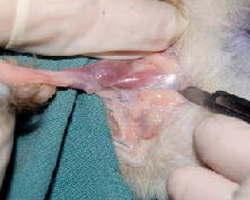
- Figure 2
The subcutaneous tissues are cleared until the penis and the ischiocavernosus (IC) muscles (arrow) are clearly visible.

- Figure 3
The IC muscle is isolated, clamped and transected between hemostat and tuber ischium.
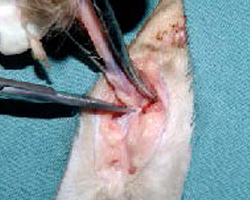
- Figure 4
The ventral fascia securing the penis to the pubis is cut.
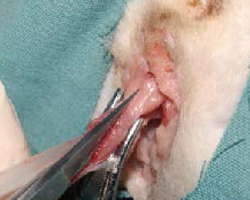
- Figure 5
An incision is made over the urethra and extended with straight iris scissors along the dorsum of the urethra up to and in between the bulbourethral glands.
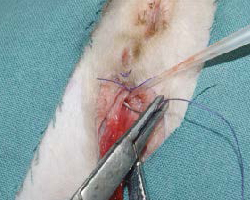
- Figure 6
Skin to mucosa sutures are placed at 12o’clock, then 1:00 and 11:00 o’clock. I like to use 4-0 Vicryl Rapide for suturing.
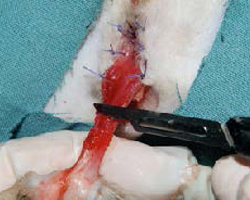
- Figure 7
Skin to mucosa sutures are continued distally on either side of opened urethra (drainboard); the distal portion of the penis is amputated. The remainder of the drainboard is sutured to the skin.
Get Ready to Perform a PU
Preferred instrumentation for this surgery:
- Straight iris scissors (sharp ones!)
- Small Adson or thumb forceps
- Small needle drivers
- Curved mosquito hemostats (3 – 4)
- 4-0 or 5-0 Vicryl Rapide ™ or MonocrylI ™
Post-operative Considerations:
- Manage the cat’s pain! Otherwise they won’t urinate for 48 hours.
- User an E-collar or equivalent
- Avoid clay based litter (2 weeks)
- Manage urolithiasis with appropriate diet
- Recheck in 2 weeks, expect to see some constriction to the new stoma
What you get when you register for this course:
- A comprehensive look at the feline LUT anatomy for a better understanding of how the surgery works
- A step by step fully narrated pictorial description of the surgery
- A narrated video of a PU being performed on a patient.
- Tips and tricks to help make the surgery go smoothly
- An understanding of what to avoid while in surgery
- A list of instruments needed to perform the surgery with greater ease
- A discussion on catheters for cats
- Information on how to manage a urethral tear in a cat
- Information on short and long term post-operative care

Q & A
How long do cats live after PU?
- A PU cat can have a long life with a successful unblocking and surgery
- Renal issues can be expected if they have had prolonged/multiple blockages
- Cats presenting with severe azotemia are more prone to succumbing to renal failure if not managed quickly
What is a cat’s quality of life (QoL) after a PU surgery?
In a study published in 2020, 100% of cat owners reported a good-to-excellent QoL after this procedure (75% reported excellent). Re-blockage in cats with a properly done PU occurs in less than 1.7% of cases (J Feline Med Surg. 202022:582-588).
Workshops & Courses
Blog
 The Secret to having the Bandage stay Above the StifleJuly 3, 2024 - 1:44 pm
The Secret to having the Bandage stay Above the StifleJuly 3, 2024 - 1:44 pm Common Mistakes made by Veterinarians when doing the Drawer TestJune 26, 2024 - 9:22 am
Common Mistakes made by Veterinarians when doing the Drawer TestJune 26, 2024 - 9:22 am Burying the end knot in a continuous subcutaneous suture patternJune 19, 2024 - 7:35 pm
Burying the end knot in a continuous subcutaneous suture patternJune 19, 2024 - 7:35 pm Creating Donuts for your BandagesJune 12, 2024 - 3:15 pm
Creating Donuts for your BandagesJune 12, 2024 - 3:15 pm The Knotless Suture PatternJune 5, 2024 - 2:45 pm
The Knotless Suture PatternJune 5, 2024 - 2:45 pm

